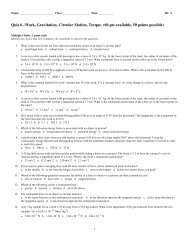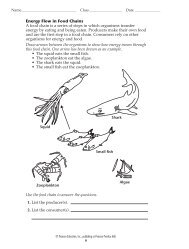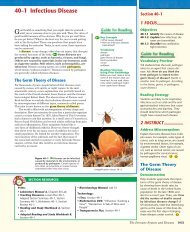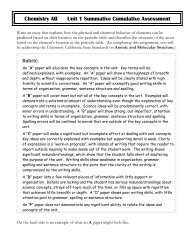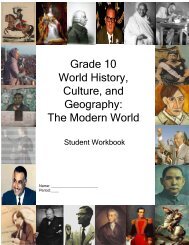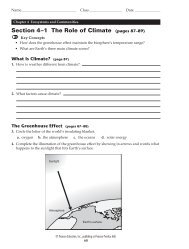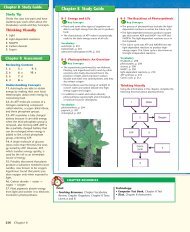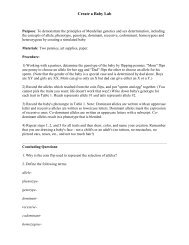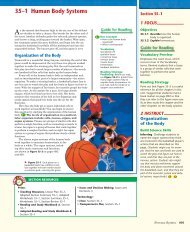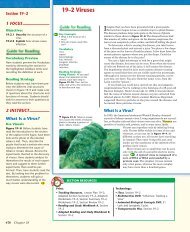4-3 Biomes - Downtown Magnets High School
4-3 Biomes - Downtown Magnets High School
4-3 Biomes - Downtown Magnets High School
- No tags were found...
Create successful ePaper yourself
Turn your PDF publications into a flip-book with our unique Google optimized e-Paper software.
Average Temperature (°C)Philadelphia,Pennsylvania403020100-10-20TigerBeetle4m-30 0J F M A M J J A S O N DMonth400300200100Average Precipitation (mm)WhitetailDeerTemperate ForestTemperate forests contain a mixture ofdeciduous and coniferous (koh-NIF-ur-us)trees. Coniferous trees, or conifers,produce seed-bearing cones, and mosthave leaves shaped like needles. Theseforests have cold winters that halt plantgrowth for several months. In autumn,the deciduous trees shed their leaves. Inthe spring, small plants burst out of theground and flower. Soils of temperateforests are often rich in humus (HYOOmus),a material formed from decayingleaves and other organic matter thatmakes soil fertile. Abiotic factors: cold to moderatewinters; warm summers; year-roundprecipitation; fertile soils Dominant plants: broadleafdeciduous trees; some conifers;flowering shrubs; herbs; a groundlayer of mosses and ferns Dominant wildlife: Deer; blackbears; bobcats; nut and acorn feederssuch as squirrels; omnivores such asraccoons and skunks; numeroussongbirds; turkeys Geographic distribution: easternUnited States; southeastern Canada;most of Europe; and parts of Japan,China, and AustraliaNorthwesternConiferous ForestBuild Science SkillsApplying Concepts Point out thatthe temperate forest biome in northeasternregions of North America andAsia is noted for its striking colored fallfoliage. If students do not live in anarea that experiences this seasonalchange, urge them to collect photographsof fall foliage. Also suggest thatthey obtain booklets and other touristguides that describe the best timesand locations for foliage viewing atdifferent latitudes within the biome.Build Science SkillsClassifying Collect photographs ofvarious types of animals that arecharacteristic of each major landbiome. Number the photographs,and display them in random order.Working individually or in pairs, studentsshould try to determine thebiome(s) in which each animal mightlive. In a follow-up class discussion,let students compare their choicesand explain their reasoning.Average Temperature (°C)Seattle, Washington403020100-10-20150 m400-30 0J F M A M J J A S O N DMonthFlyingSquirrel300200100Average Precipitation (mm)Black BearMild, moist air from the Pacific Oceanprovides abundant rainfall to this biome.The forest is made up of a variety ofconifers, ranging from giant redwoodsalong the coast of northern California tospruce, fir, and hemlock farther north.Moss often covers tree trunks and theforest floor. Flowering trees and shrubssuch as dogwood and rhododendron arealso abundant. Because of its lush vegetation,the northwestern coniferous forest issometimes called a “temperate rain forest.” Abiotic factors: mild temperatures;abundant precipitation duringfall, winter, and spring; relatively cool,dry summer; rocky, acidic soils Dominant plants: Douglas fir, Sitkaspruce, western hemlock, redwood Dominant wildlife: bears; largeherbivores such as elk and deer;beavers; predators such as owls, bobcats,and members of the weasel family Geographic distribution:Pacific coast of northwestern UnitedStates and Canada, from northernCalifornia to AlaskaFACTS AND FIGURESLayers of plant growthIn a temperate forest, there may be up to fivelayers of plant growth. The tallest trees make upthe canopy layer; often this layer consists of onlyone or two dominant species. Under the canopyis a layer of shorter trees called the understory.Below the understory is a shrub layer made up ofshort, branching, woody plants. An herb layerconsisting of grasses, ferns, and annual wildflowersgrows close to the ground. Finally, there is theground layer, which consists of mosses, fungi,and leaf litter.Ecosystems and Communities 103
Other Land AreasSome areas of land on Earth do not fall neatlyinto the major biome categories described on theprevious pages. These areas include mountainranges and polar ice caps.Mountain Ranges Mountain ranges can befound on all continents. On mountains like theone in Figure 4–12, the abiotic and biotic conditionsvary with elevation. As you move up frombase to summit, temperatures become colder andprecipitation increases. Therefore, the types ofplants and animals also change. If you were toclimb the Rocky Mountains in Colorado, forexample, you would begin in a grassland. Then,you would pass through an open woodland ofpines. Next, you would hike through a forest ofspruce and other conifers. Near the summit, youwould reach open areas of wildflowers andstunted vegetation resembling tundra. In theCanadian Rockies, ice fields occur at the peaksof some ranges.Polar Ice Caps The icy polar regions thatborder the tundra are cold year-round. Outside ofthe ice and snow, plants and algae are few but doinclude mosses and lichens. In the north polarregion, the Arctic Ocean is covered with sea ice,and a thick ice cap covers most of Greenland.Polar bears, seals, insects, and mites are thedominant animals. In the south polar region, thecontinent of Antarctica is covered by a layer of icethat is nearly 5 kilometers thick in some places.There, the dominant wildlife includes penguinsand marine mammals.4–3 Section Assessment1. Key Concept List themajor biomes, and give onecharacteristic feature of each.2. How are biomes classified?3. What are the two types of tropicalforest? How do they differ?4. How might a mountain rangeaffect the types of plants andanimals found in an area?5. Critical Thinking InferringWhat characteristics would youexpect tundra animals to have?4 –3 Section Assessment1. Students should list the major biomes alongwith one characteristic of each.2. By their climate, which is determined byprecipitation and temperature, and by thecommunity of organisms that live there3. Tropical rain forests have higher temperaturesand more rainfall annually than dotropical dry forests.4. Animals and plants found in mountainranges must be adapted to the generally Figure 4–12 Washington’s Mount Rainier towersabove the tree line. Applying Concepts Based onwhat you have seen in the previous pages, which biomelies at the base of this mountain?NSTAFor: Links on biomesVisit: www.SciLinks.orgWeb Code: cbn-20436. Critical Thinking Comparingand Contrasting Choose twovery different biomes. From eachbiome, select a plant and ananimal that are dominant.Compare how these plants’adaptations are suited to theirbiomes. Compare how theseanimals’ adaptations are suited totheir biomes.Interdependence inNature Choose one of thebiomes discussed in this section.Then, depict the biomein a piece of artwork. Includethe biome’s characteristicplant and animal life in yourart. Add labels to identify theorganisms, and write a captiondescribing the content of theartwork.cooler, wetter conditions that are foundthere.5. Sample answer: Tundra animals need to bewell insulated with thick coats of fur/hair orlayers of feathers.6. Answers may vary. Students might select anyplants and animals mentioned in the profilesof the 10 biomes. In their comparisons, theyshould discuss specific adaptations of theorganisms.3 ASSESSEvaluate UnderstandingBriefly describe characteristics of variousbiomes, and call on students atrandom to identify each one. Forexample, if you say, “<strong>High</strong> temperaturesthat do not vary muchthroughout the year,” studentsshould identify the biome as a tropicalrain forest or a tropical savanna.Base your descriptions on the informationpresented on pages 100–104of the student text.ReteachMake overhead transparencies of theclimate diagrams for each of the landbiomes. Project the diagrams in anyorder. For each diagram, call on onestudent to summarize the diagram’sinformation about temperature andprecipitation (for example, “<strong>High</strong> temperaturesand heavy rainfallyear-round”), and call on a secondstudent to identify the biome.This activity can be completedindividually or in small groups.Provide students with a variety ofmaterials to choose from, includingbasic art supplies, modelingclay, pasta shapes, pipe cleaners,fabric, and construction paper.You might also encourage studentsto bring materials fromhome, or you might coordinatethis activity with an art class atyour school. Encourage studentsto be creative but accurate indepicting the biomes.Answer to . . .NSTADownload a worksheeton biomes for students to complete,and find additional teachersupport from NSTA SciLinks.If your class subscribes to theiText, use it to review the KeyConcepts in Section 4–3.Figure 4–12 Boreal forestEcosystems and Communities 105



